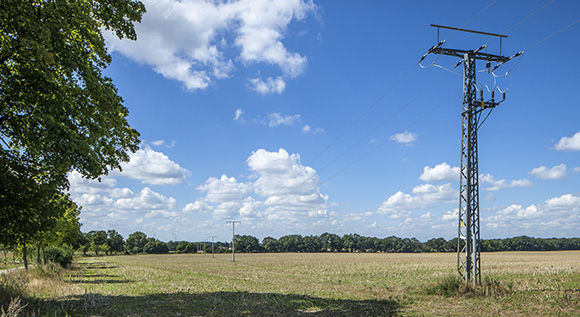Getting the grid in shape
A fitness test for electricity grids: new measurement system for grids can provide precision information on the state of the grid and evaluate huge quantities of data in no time at all. In doing so, it can help make the power grid fit for the energy transition.
 © BMWi / Holger Vonderlind
© BMWi / Holger Vonderlind
Many people are looking forward to the summer holidays. This is no surprise, as for many, the sunny weather is also the time for an extended getaway. And for congestion on the highways.
Congestion on the electricity highway
The more sun, the greater the congestion. This is not only true on our roads, but also on the electricity highway. In cloudless and windy skies, solar installations and wind turbines feed a high amount of electricity into the grid. When the clouds cover the sun and the wind speed drops, so too does the electricity feed-in. The electricity grid has to cope with this rise and fall. This is not only true for the large transmission grids that transport electricity over long distances, but also for the smaller distribution networks. Like exits off the highway, these networks serve to bring the transported electricity to far-flung destinations, and directly into your living-room.
Coping with these fluxes is no mean feat. The more green electricity that flows into Germany’s grids, the better this volatile power needs to be absorbed. On top of this, there are also new technologies, such as electric vehicles or bikes, which are sometimes re-charged during the daytime, and sometimes at night. And in future, distribution grids will not only deliver electricity but will increasingly absorb green energy from renewable energy installations, such as electricity that is fed in from solar panels on roofs.
In order to cope with all of these variables, new technical solutions need to be found. One such solution has just been developed in the municipality of Wachtendonk, close to the Dutch border.
Low voltage fitness test
Three technology companies and two universities have joined forces on behalf of the public utilities of the city of Krefeld to make low-voltage grids fit for the energy transition. This is the part of the grid that supplies the majority of final consumers with electrical energy and directs the electricity to individual households. Researchers and developers want to use a new measurement system like a fitness test to determine whether the grids in a particular area where the energy transition is advancing are under strain. As part of this process, precise measurement data is lifted at important junctions within the electricity grid, such as in cable distribution cabinets or in substations. This gives rise to large volumes of data which are bundled and evaluated almost in real time.
Taking measurements before taking action
If the new system reveals that the voltage in the grid is too high, it then transmits this value to the grid operator, similar to the idea behind a heart rate monitor. This reading can be used in the future to take the necessary action to remedy this issue without delay. In this way, the low-voltage grid remains stable and the supply of electricity to all the nearby residents secure. Researchers can also use this system to identify whether the low-voltage grids need to be expanded or whether they still provide sufficient capacity for new households that move to the area to be connected in the future or for further renewable energy installations to be connected to the grid.
The measurement system project is called ENERGIE and will run until the end of August 2016. It is being funded by the Federal Ministry for Economic Affairs and Energy as part of its ‘Future Energy Grids’ initiative, and has been nominated for the GreenTec Award. The award is to presented to the final winner in Munich on 29 May 2016.

